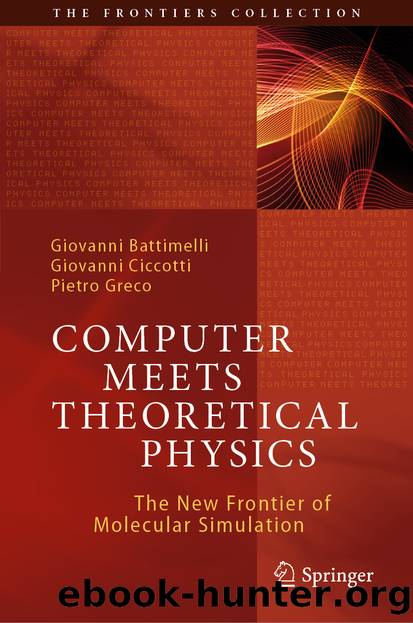Computer Meets Theoretical Physics by Giovanni Battimelli & Giovanni Ciccotti & Pietro Greco

Author:Giovanni Battimelli & Giovanni Ciccotti & Pietro Greco
Language: eng
Format: epub
ISBN: 9783030393991
Publisher: Springer International Publishing
Again , Berendsen recalls: «Although the application to biological molecules—such as proteins—had been developed in several places, Harvard in particular, by the group of Martin Karplus , it is probably fair to say that CECAM activities were inspirational in this field of study, and certainly stimulated further activities both in Europe and in the USA». In this statement, we may note Herman Berendsen’s modesty, since he had also realized significant computer simulations of the behaviour of biological molecules.
Good ideas and computer power: this is the secret of molecular dynamics. In comparison with 1976, Emanuele Paci recalls forty years later, the second element—computer power—has grown dramatically. By now, molecular dynamics can deal with a very large number of biomolecules and longer times, of the order of hundreds of microseconds (one microsecond is equal to a millionth of a second). However, «the methodology has changed little since, and several of the present-day challenges had already been clearly stated then».24 The right ideas had already been put on the table at Orsay in 1976.
In sum, the workshop at CECAM between May and July was a source of great inspiration. Wilfred van Gunsteren recalls a climate of close and effective cooperation: «The participants that stayed for the whole two-month duration of the workshop did not only enjoy the goodies of Paris at the time, but also the close cooperation during eight weeks between scientists contributing different expertise to make progress towards the goal of simulating the behaviour of biomolecular systems. It goes without saying that Herman Berendsen was instrumental to this process of interaction».25 It is also true that at Orsay, between May 24 and July 17, 1976, the SHAKE algorithm probably gave a significant boost to the study of the molecular dynamics of proteins and other biological macromolecules. Indeed, this algorithm would be used for many years to come, and it is still used today. Moreover, it triggered the imagination of several scientists specialized in applied mathematics, who were trying to identify the mathematical reasons for its validity. The successful features of this algorithm are the following: (1) it does not add to the error of any algorithm for the integration of the system motion; (2) it is “symplectic”, i.e., it is one of the best algorithms for the integration of dynamics.
No doubt, as the workshop came to its end, all participants were convinced that a new window had been opened in the field of molecular dynamics. From then on, it would be possible to study the complex molecules of life.
Footnotes
1M. Karplus, Carl Mathew Moser, Carl Moser Symposium, CECAM, Lyon 2005.
Download
This site does not store any files on its server. We only index and link to content provided by other sites. Please contact the content providers to delete copyright contents if any and email us, we'll remove relevant links or contents immediately.
Algorithms of the Intelligent Web by Haralambos Marmanis;Dmitry Babenko(16234)
Jquery UI in Action : Master the concepts Of Jquery UI: A Step By Step Approach by ANMOL GOYAL(9385)
Test-Driven Development with Java by Alan Mellor(7729)
Data Augmentation with Python by Duc Haba(7606)
Principles of Data Fabric by Sonia Mezzetta(7378)
Learn Blender Simulations the Right Way by Stephen Pearson(7294)
Microservices with Spring Boot 3 and Spring Cloud by Magnus Larsson(7137)
Hadoop in Practice by Alex Holmes(6587)
RPA Solution Architect's Handbook by Sachin Sahgal(6515)
The Infinite Retina by Robert Scoble Irena Cronin(6215)
Big Data Analysis with Python by Ivan Marin(5931)
Life 3.0: Being Human in the Age of Artificial Intelligence by Tegmark Max(5507)
Pretrain Vision and Large Language Models in Python by Emily Webber(4894)
Infrastructure as Code for Beginners by Russ McKendrick(4652)
Functional Programming in JavaScript by Mantyla Dan(4434)
WordPress Plugin Development Cookbook by Yannick Lefebvre(4379)
The Age of Surveillance Capitalism by Shoshana Zuboff(4243)
Embracing Microservices Design by Ovais Mehboob Ahmed Khan Nabil Siddiqui and Timothy Oleson(4146)
Applied Machine Learning for Healthcare and Life Sciences Using AWS by Ujjwal Ratan(4134)
